Inside a mom’s months-long fight to get back her children
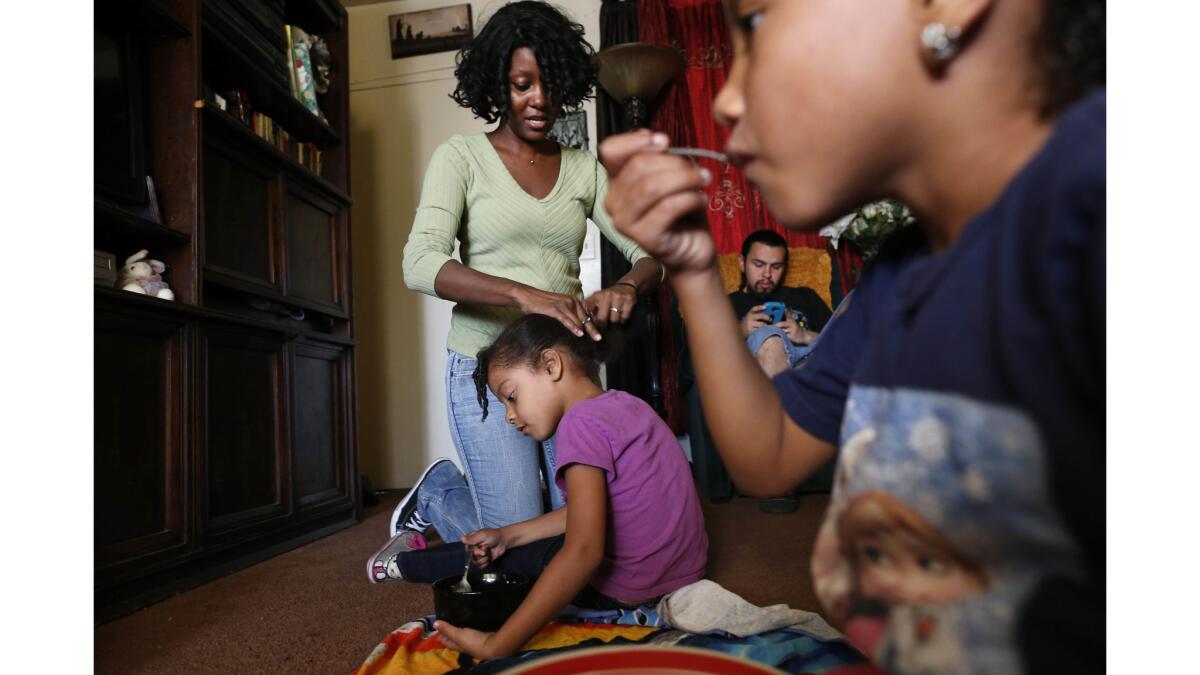
- Share via
On an unseasonably warm January afternoon a case worker with the Los Angeles County Department of Child and Family Services approached a mid-century apartment complex in Pomona to perform one of the most emotionally charged tasks in public service.
Flanked by police officers, she passed a cluster of five skinny palms, entered the building’s courtyard and rapped on a door.
Inside, with two of her four children sitting quietly, Monique Baker raced about preparing for a move the family had scheduled for two days later. Cracking open the door, she instantly recognized what was happening.
Within minutes, the officers were leading away Baker’s two oldest children, Jaeson, 14, and Angelica, 11, citing concerns that the mother’s mental health prevented her from caring properly for her children.
Then members of the team drove to Baker’s father’s house in Diamond Bar where her younger children were staying while awaiting the move into a new apartment. They took Amor, 6, and Anicia, 4, into protective custody as well.
Back at the children’s services office, Jaeson escaped into five hours of sleep. Angelica went mute. Anicia wailed. Amor looked down and realized she was wearing two left shoes.
It would take Baker more than 10 months to regain custody of her children.
Los Angeles County’s child abuse hotline receives a call every three minutes, on average. The calls are heavily concentrated in communities of South Los Angeles and the Antelope Valley where large numbers of black families reside, DCFS records show. Roughly one out of three black children in Los Angeles County is reported to the hotline by the time they are 5 years old, according to research by Emily Putnam-Hornstein, a professor at USC’s School of Social Work.
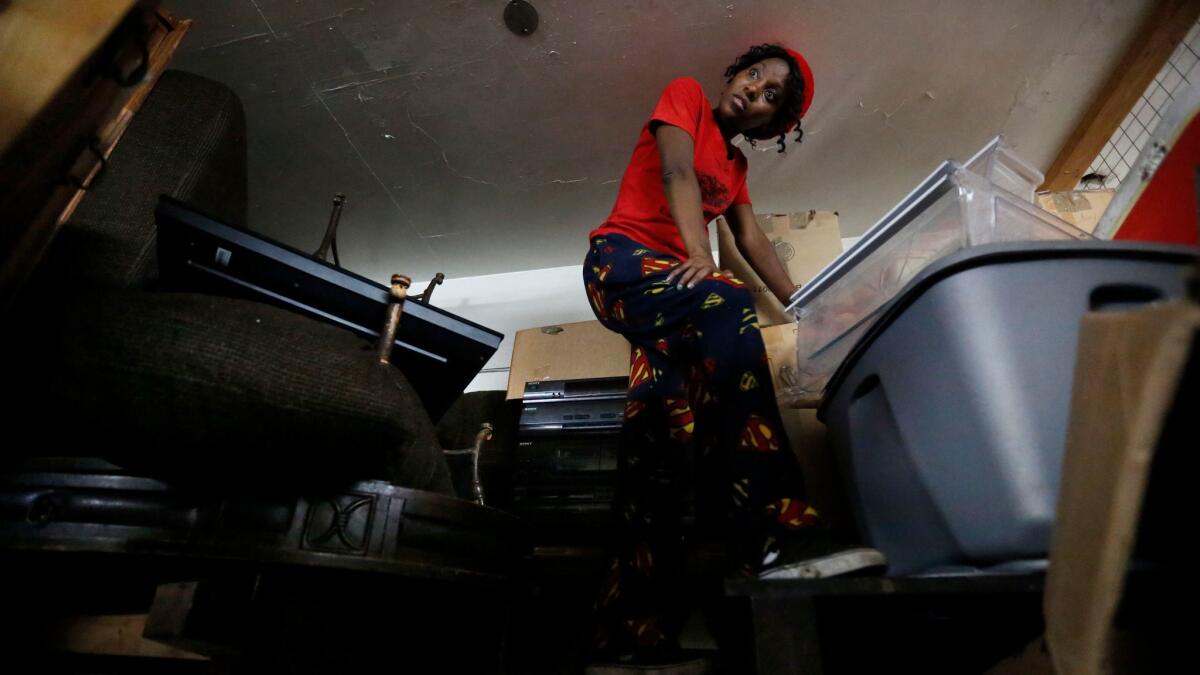
Black children enter foster care at five times the rate of white children and linger there, without being returned to their parents or being adopted, two months longer than white children, according to DCFS records.
Baker woke up in her car with her Maltese-Yorkshire dogs, Carmine and Bella, crawling over her.
—
This is one of the most vexing problems facing the nation’s child protective services field. As it happens, the period during which Baker struggled to regain custody of her children corresponded with the county’s efforts to address this disparity through the use of “cultural brokers” — volunteer grandmothers, preachers and other black community members who, the controversial theory holds, have insight into the unique character of African American families and the challenges they face.
It also corresponded with the erosion of key legal protections for families in Los Angeles County.
Why do more L.A. County black children end up in foster care? Experts clash over the reason »
By law, child dependency courts are required to quickly examine social workers’ allegations about a family. Within three days a family is entitled to an initial hearing. The next hearing, which must be held within 15 days, decides whether the charges are true and amount to abuse, neglect or both.
But Los Angeles County authorities often miss that second mandatory deadline, records show, with a resulting chain reaction that can cause the process of reuniting or dismantling a family to drag on for months, as Baker’s family was about to discover.
Michael Levanas, the presiding judge of Los Angeles County Juvenile Court, declined to release data for the full backlog of cases.
But The Times obtained confidential Los Angeles County Superior court records revealing that during a single month shortly before the county took Baker’s son and daughters — and at a time when about 950 children a month were being put under court supervision — 348 had been held for three months or more without a ruling to determine whether the abuse and neglect allegations were true and, if so, what to do about them.
For some families, the ruling was more than a year overdue.
Levanas acknowledged that delays have become common as the number of children entering the system increased at the same time that the state cut the court’s budget.
Lawyers representing parents and children, he said, “are underfunded and carrying crushing caseloads.”
Levanas also noted that parents have a right to demand formally that hearings occur within the required time frame, and that the court honors those formal requests.
Many experts, however, say that relatively few families have the wherewithal to navigate the complexities of those formal requests.
County taxpayers spend $2 billion a year on child protective services, yet confidentiality laws usually guarantee that experiences like Baker’s remain hidden from public view.
But a special court order allowed a reporter to be present for Baker’s interactions with child protective services and the courts. And Baker gave the reporter permission to examine her case materials, review her mental health history and observe her life for this story, which was produced in collaboration with the Investigative Reporting Program at
::
Baker, 36, was born to a mother who had developed mental illness. She and Baker’s father, a middle manager at a utility company, divorced when Baker was 1 year old. The girl was raised by her father and his second wife in the San Gabriel Valley town of Diamond Bar.
Monique’s life took its most significant hard turn, she says, when she was 21. A man plied her with drug-laced tequila and raped her. She woke up in a bathtub two days later with the water running and her sister screaming. From then on, she says, she had trouble in school and at various jobs.
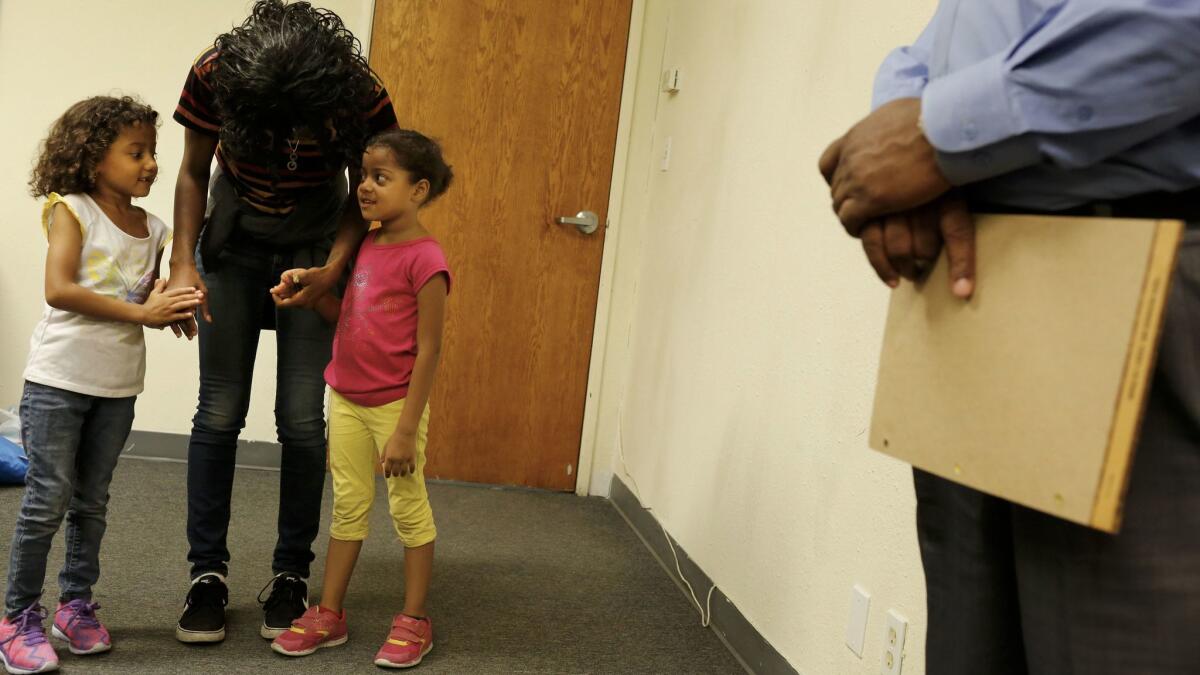
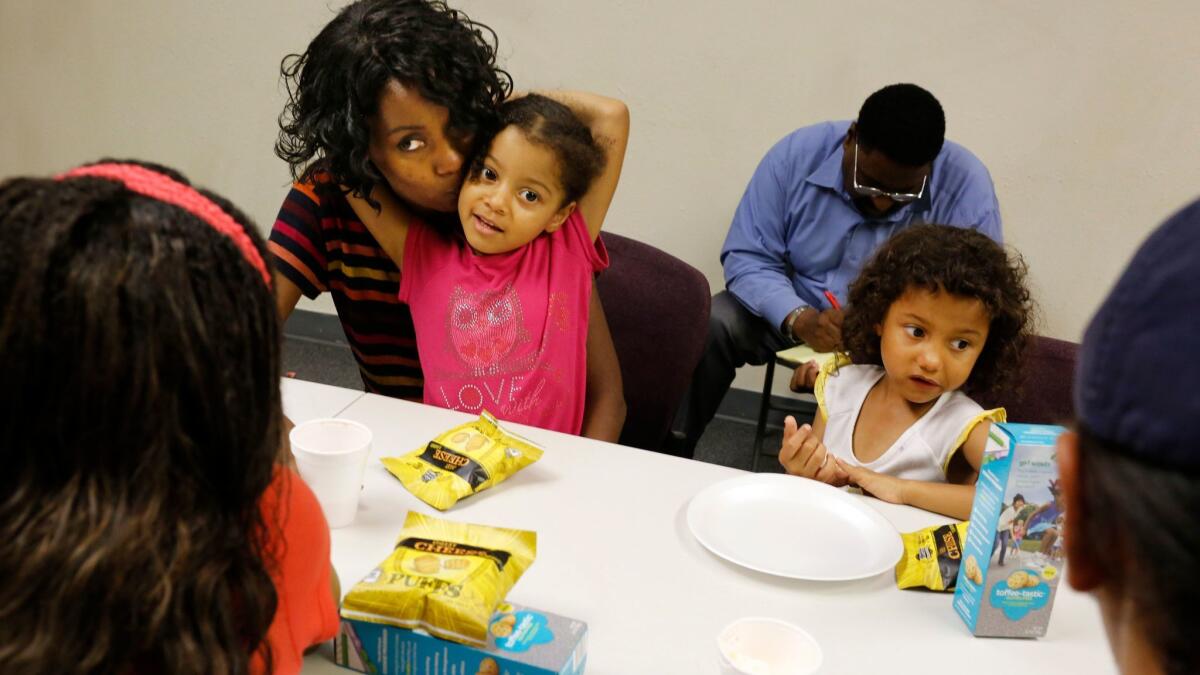
The next big change in her life came with the birth of her first child.
Jaeson was a good boy but a handful who seemed to believe his own fantastical stories, Baker says.
In 2007, child protective services got a call that he’d been showing up at school covered with a foul odor. The report was determined to be meritless, according to child welfare records. But there were more calls to the child abuse hotline about Jaeson and in 2009 social workers took Baker’s four children to an emergency shelter, saying that she was struggling with anxiety and could not maintain a clean home.
With the court’s permission, Baker’s father brought the children into his house in Diamond Bar. Eventually a judge allowed Baker to move in as well, and in 2010, the court restored full custody of her children.
But Baker’s fears lurked, developing into the anxiety disorder agoraphobia, a fear of embarrassment or loss of control in public places. It effectively rendered her housebound.
Baker calls anxiety “my curse,” and she watched with sadness as her second oldest child, Angelica, began saying she was afraid to go to school.
I hate it when I hear, ‘We’re helping you because you are a black family and we want to see a black family put back together.'
— Monique Baker
Jaeson’s behavior, meanwhile, continued to grow more bizarre. But he was not without his insightful moments.
A bookish boy, he took notice of a neighbor, Mario Sanchez, who routinely walked past Baker’s apartment with armloads of books.
One afternoon Jaeson invited him over, and Sanchez and his mother began to talk.
Sanchez explained that the Marvel superheroes he had tattooed on his body helped him feel less powerless when recalling the childhood memory of seeing his mother shot and killed.
Baker, in turn, revealed her own fears.
It was the first time Sanchez had heard the term “agoraphobia.” Sympathetic, he offered to walk her to the corner.
A month after they met, “Baby Love” was able to go almost anywhere with a measure of assurance, as long as “Square Bear” was at her side. They married a year later
Jaeson’s behavior, however, continued to decline. Sometimes he smeared feces in his room. He began telling odd tales about such things as trips his mother had supposedly taken to Hawaii.
The family got him mental health treatment, but the strain grew. Three times the boy was hospitalized and then released back to his family.
In late 2014, Jaeson told a therapist that his siblings were not receiving the counseling that doctors had said they needed. The therapist called the hotline and DCFS assigned an African American social worker named Lisa Whitehurst to the case.
Los Angeles County social workers find themselves in a bind. If they intervene too aggressively to protect children, they’re accused of callously ripping families apart; if they fail to intervene, the consequences can be tragic and the roar of criticism vastly more intense.
Whitehurst’s investigation led a judge to issue the warrant for the removal of Baker’s children on that January afternoon.
Now, Whitehurst and her colleagues had three days to prepare the “failure to protect” petition that would try to persuade a judge at the formal detention hearing that the children should not be returned to the home immediately, if at all.
The report charged Baker with three violations of the state welfare and institutions code that defines abuse and neglect for decisions about whether children should enter state custody:
One: Baker’s house is “filthy,” placing “the children at risk of physical harm, damage and danger.”
Two: Baker is not taking her children for psychiatric treatment.
Three: Baker has “mental and emotional problems, including major anxiety disorder, major depression and PTSD, which renders the mother unable to provide regular care.”
“Through the open door,” an unnamed worker wrote, “this child social worker could see the home was in complete disarray, including a mattress on the floor, belongings spread all across the floor…. the smell of animal urine/feces came through the windows and the front door.”
She noted, too, that after being taken into custody, Jaeson had collapsed into sleep in her Pomona office, and that when he awoke hours later, he blamed his fatigue on his mother, who, he said, made him sleep in a cabinet.
The caseworker’s notes show that she pressed him on this allegation.
“Yes,” he said, “In a cabinet.”
The family said that never happened,.
::
Baker’s hearing was brief, one of dozens that occur each day across Los Angeles County’s dependency courts.
As is usually the case in Los Angeles County, a court-appointed attorney sat in the courtroom and conferred with a steady stream of parents as they trooped in and out as if on a conveyor belt.
Parents typically do not have an opportunity to present their version of the situation at detention hearings, and Baker’s case was no exception.
The court quickly ruled, based on the caseworkers’ report, that the children should remain out of their mother’s care pending a hearing to decide the truth of the allegations.
The court sent Jaeson to an institution to deal with his mental health needs and sent the the three girls back to foster care.
Angelica could not gather words to speak as she learned her fate. Shyly, she slipped a note to a caseworker: “I think she’s a wonderful mom, at least in my mind.”
The clock was ticking on a one-year deadline to comply with the court’s directives . . . or risk losing her parental rights forever.
—
::
It was only a few weeks later that Baker woke up in her car with her Maltese-Yorkshire dogs, Carmine and Bella, crawling over her. The seat backs and armrests were covered with clothes.
On the dash was a plaque with pink-frosted glass that her oldest daughter, Angelica, had given her. It read: “Home is where your family lives.”
With the children gone, so were the payments the county welfare office sent to take care of them, and the couple’s social security checks alone could not make the rent payments on the new apartment they’d lined up for the family.
That left Baker and Sanchez living on the streets, often parking behind a Diamond Bar KFC where one of the employees put leftover chicken on top of the trash can for them.
Now, five months later, in May 2015, Los Angeles County Department of Child and Family Services had scheduled the first official meeting at which a team would come together to talk to Baker about her family’s fate.
In the restroom of a city park, she draped her thin frame in a cheery combo: apple green blazer and a purple dress that ended just above the tattoos of her children’s names. Over her roughly cropped fade, she fastened a wig with shiny curls, then dabbed perfume under her chin, hoping the scent would camouflage her desperation.
Arriving at the DCFS office in Pomona, she sat down at a round table. Soon nine other people were gathered around: mental health therapists for the children, caseworkers from child protective services, and a school counselor who has known and supported Baker and her children for years.
Her father arrived late with three of Baker’s children and Angelica joined the adults at the table while her two younger siblings played with toys on the floor.
Baker tried to project the image of a responsible mother. A plastic folder in front of her contained, among other documents, the report that caseworkers had written to justify removing the children from Baker’s care. Baker had annotated it with fierce scrawlings, noting misspellings and grammatical flaws, but also assertions she saw as falsehoods, inconsistencies and injustices.
One violation of her rights, in Baker’s mind, was that the caseworker report had erroneously cited several mental disorders even though the worker had no access to the mother’s confidential psychiatric evaluations. The latest evaluation, written in 2010 and reviewed by The Times, said her mental illness was in remission.
As for the assertion that the apartment was “filthy,” Baker said it was simply in the disarray any home is in while a move is underway. The caseworker never actually entered the house, but merely looked through the door, Baker pointed out.
She also took issue with Whitehurst’s first visit to her home, a few weeks before the county removed her children from her care, complaining to the authorities at that recorded meeting that Whitehurst, in an apparent effort to establish rapport, had told her that she was from Compton and knew what she was going through.
“I don’t have anything to do with the ghetto or Compton,” Baker said. “I’m from a middle class neighborhood in Diamond Bar.”
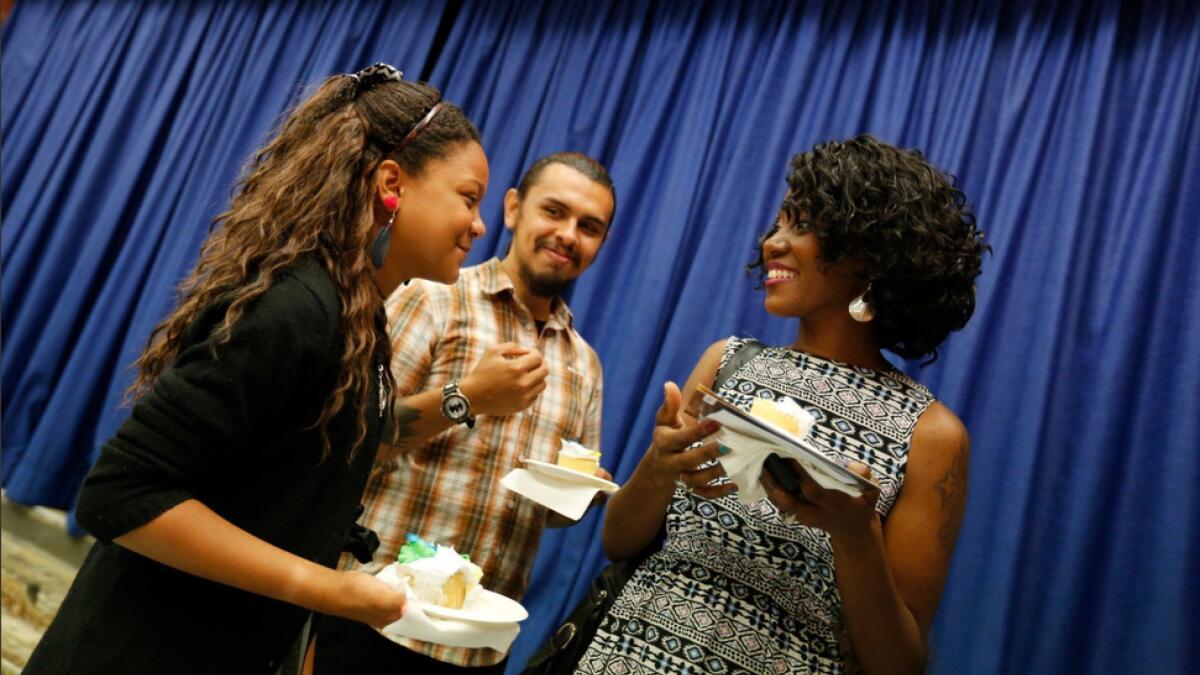
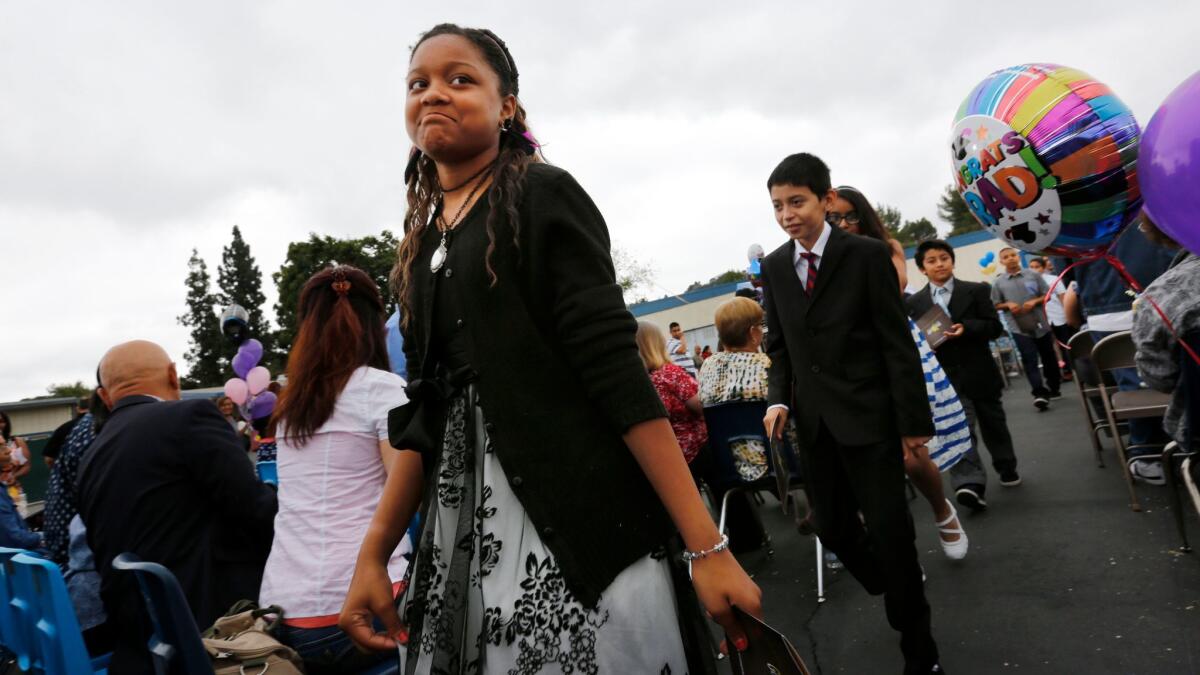
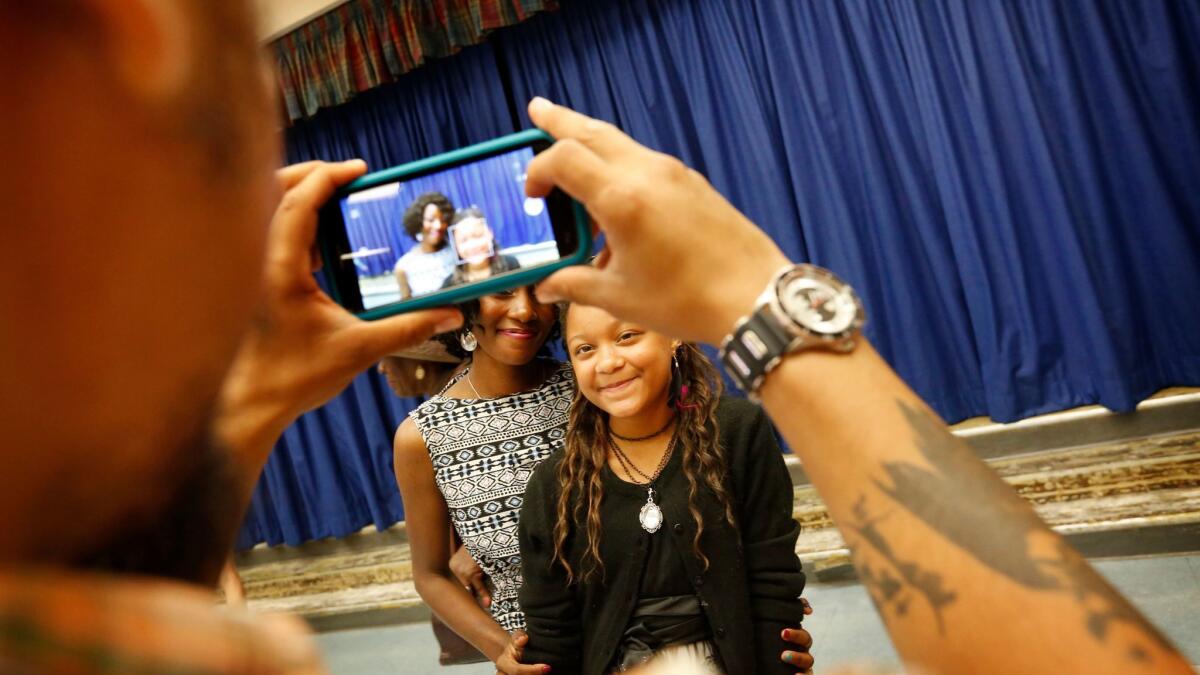
Baker had complained about the exchange to officials at DCFS, arguing that Whitehurst was stereotyping her, and that it amounted to racial discrimination. Whitehurst declined to comment for this story. Her supervisors declined to tell Baker if anything came of her complaint.
Adding to Baker’s anxiety at the meeting was her ever-present recognition that the clock was already ticking on a one-year deadline to comply with the court’s directives on how to become a better mother, or risk losing her parental rights forever. DCFS caseworkers were already contacting relatives to ask if they would want to adopt the children.
But even though the legal deadline to determine the fate of Baker’s family had passed two months earlier, the court had yet to issue a single directive.
So if someone at the table suggested that Baker do something, she nodded her head and said she’d do it.
A caseworker mentioned an available seat at a class for substance abusers, saying it might fulfill a requirement for parenting classes. Although there had never been a hint of drug or alcohol abuse in her files, Baker agreed to wake up at 4:30 a.m. twice a week to attend many hours of sessions.
Because Baker is African American, the county had also included another person at the table.

The prevailing view among academics and child welfare administrators is that abuse and neglect occur at higher rates among black families following generations of deprivation and inequity, and that foster care is the only immediately available solution.
Others believe that the higher number of children removed from black homes compared with families of other ethnicities stems from caseworkers’ racial biases.
In Los Angeles County — where 550 social workers are white and 990 black — officials have adopted an approach that focuses on this bias, arguing that even black social workers may be subject to the “internalization of white thought.”
Pastor Ivory Brown, the executive director of a nonprofit called Project Sharing and Caring, was at Baker’s meeting as a cultural broker, to make sure she had someone she could relate to and who could translate black culture to the caseworkers — even though three of the four were black.
Brown suggested that Baker might be interested in the 12-week parenting class his organization offers, with taxpayer support.
So Baker enrolled in that as well, agreeing to make late-night bus trips each Monday.
But from Baker’s perspective the county’s adoption of unique practices for African American families did little but add obstacles and frustrations.
“I hate it when I hear, ‘We’re helping you because you are a black family and we want to see a black family put back together,’” Baker said. “Well, you are not helping my family — you are destroying it.”
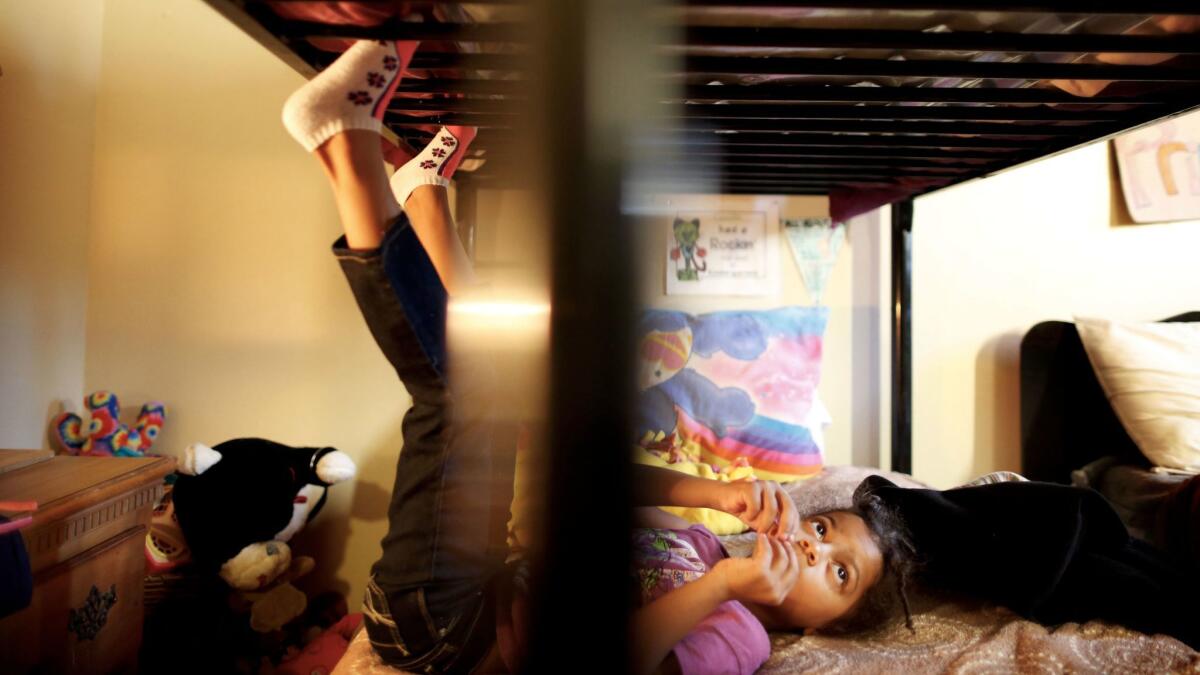
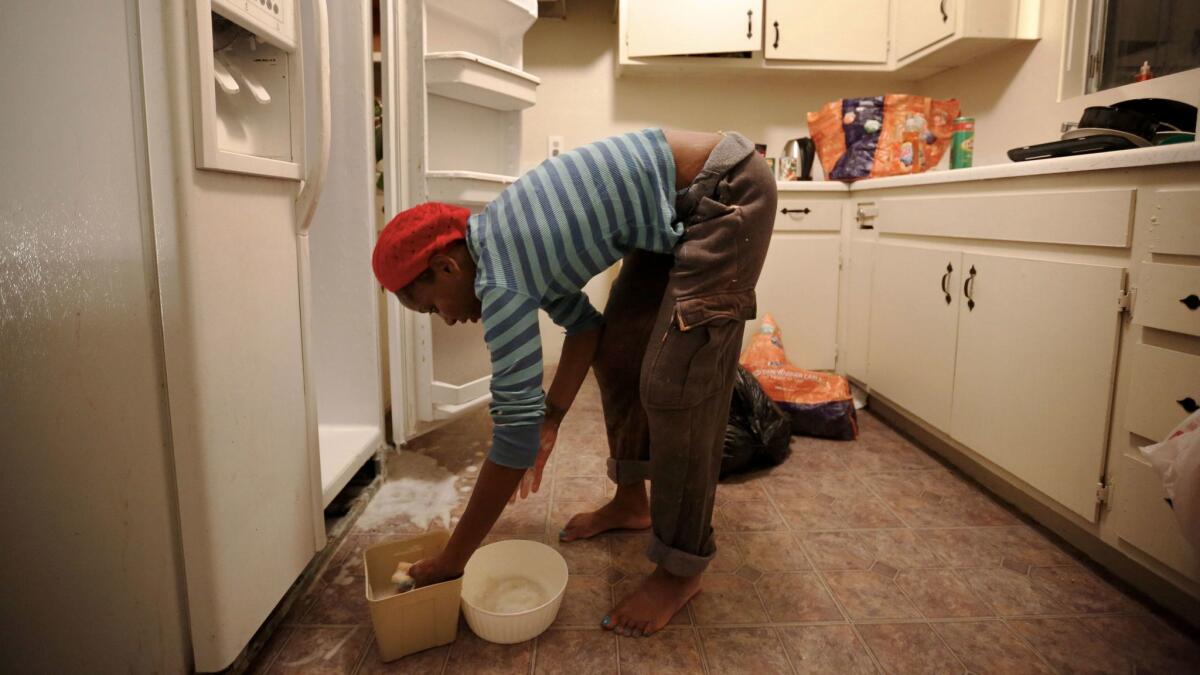
::
Eventually, as Baker and her husband waited for the system to make its decision, they moved out of their car into an apartment in San Bernardino. Sanchez had cut back on work to contend with the new requirements to get the children back and worked sporadically cleaning and gardening at area churches, so the rent came out of Baker’s $993 monthly Social Security check.
When someone from children’s services finally called to say that a caseworker would be coming to inspect the home, Baker and Sanchez rose at 5 a.m. on the day before the visit to make sure everything was in place. They even painted a tree on the wall to display family photos.
Late at night, they collapsed in exhaustion.
“Oh, my god,” Baker yelled in the dark, rising in panic. “They are going to be here. I overslept!”
Sanchez laughed. “Calm down,” he said. “You’ve only been asleep for five minutes.”
The next morning Baker was repositioning the photos when the knock came.
This time Baker’s visitor was Diquitha Aubrey, a caseworker who, Baker said, had previously told her that her mission was to put black families back together.
“So you got your place — congratulations” she said, appraising the surroundings. A few days later, someone called to say that the apartment had passed muster.
Among the final sticking points was the county’s demand that she receive a psychiatric evaluation by someone other than the psychologist she had been seeing for years.
The county, however, would not pay, so while Baker took on the frustrating task of finding an evaluator she could afford, her children marked birthdays and other milestones.
Some were positive — Angelica wrote in her diary about her first crush. But Amor was having nightmares, Anicia started wetting the bed again, and Jaeson, now diagnosed with schizophrenia, threatened someone in a youth home and entered the delinquency system.
Finally, at yet another roundtable 10 months after the children’s removal, a DCFS official agreed to have the county pay a psychiatrist at USC to perform Baker’s psychological evaluation.
The diagnosis: anxiety in remission.
::
In October 2015, Baker’s attorney’s office notified her of a scheduled hearing, and she arrived at 8:30 a.m. in the assigned courtroom.
Her lawyer pulled her into the freshly buffed waiting area.
The county, he said, would be willing to drop all of its original allegations if she agreed to the significantly less serious allegation that her mental health limited her ability to meet her children’s special needs, and if she agreed that she required ongoing psychological therapy sessions.
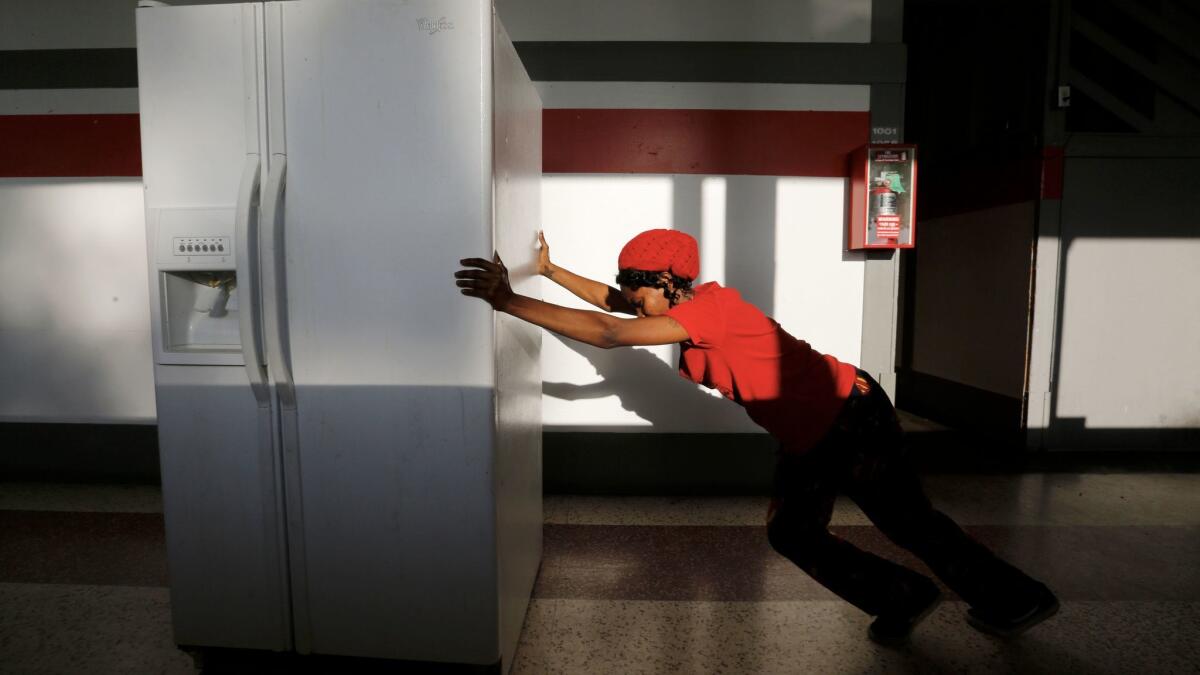
If Baker agreed, all the original charges would be dropped, and the children, aside from Jaeson, could go home with her that day.
If she fought, the lawyer said, the children, who had been moved into foster care with their grandfather, would remain there and the court would set a trial for some unknown date in the future.
I think she’s a wonderful mom, at least in my mind.
— Monique Baker's daughter Angelica
Baker told her father she had decided to admit to the lesser count: “I’m signing something I don’t believe. But he says it’s the only way to get my kids back.”
Morning turned to afternoon and one by one the mothers and fathers and children whose lives had become entangled with the system appeared before the judge then headed home.
Baker was beginning to think she would once again be sent home without her children, when, minutes before the court closed at 5 p.m., a bailiff called her name and she and her fragmented family moved to the lawyer’s table.
The youngest girl, Anicia, put her head down and slept. Angelica sat silently while Amor rocked back and forth in the swivel chair.
Judge Natalie Stone read the single remaining charge against Baker and asked how she pleaded.
The smile that Baker had kept pasted on her face for 10 months dropped away, and she stared blankly ahead.
“No contest, your honor,” she responded.
Stone ordered Baker to see a psychiatrist monthly. She said she must keep her house clean and let caseworkers in for random visits.
Then she restored custody of the children to Baker and Sanchez.
The process took 13 minutes.
Every child who leaves dependency court is given a teddy bear.
As Baker and her reunited family left the building, she pointed up to a canopy that is littered with the stuffed toys.
Parents, Baker said, must have thrown them away in disgust, unwilling to bring home memories of what they’ve been through.
“We have a whole collection of those bears,” she said. “I can’t stand them.”
::
In the following months, Baker’s anxiety stabilized. Sanchez got a job at the Burlington Coat Factory warehouse. His commute was two hours round-trip by bicycle, but the $400 a week lifted the family off welfare.
Then, in June 2016, Baker learned that the court had held another hearing.
Case closed.
Why do more L.A. County black children end up in foster care? Experts clash over the reason »
Therolf reported this story as a Los Angeles Times staff member and completed it after leaving the paper last year to become a reporter for the Investigative Reporting Program at UC Berkeley and Common Sense News, a nonprofit focused on children’s issues. He can be reached at [email protected].
Sign up for Essential California
The most important California stories and recommendations in your inbox every morning.
You may occasionally receive promotional content from the Los Angeles Times.








